
Choosing a dissertation topic can feel overwhelming. It’s a decision you’ll live with for months or even years.
In this guide, we’ll show you how to choose a dissertation topic that’s interesting, feasible, and meaningful. You’ll learn key steps, see real examples in business, nursing, and psychology, and discover when a dissertation writing service can help.
Whether you’re an undergrad, master’s, or PhD student, the process is more similar than you think.
Why Your Dissertation Topic Matters
Your dissertation topic guides your entire research journey.
It decides what you’ll study, write about, and live with for months or years. So, choose one that excites and challenges you.
Expectations vary by level: undergraduates can explore existing issues in depth; master’s students should offer fresh insights; PhD candidates must make an original contribution.
Picking the right topic keeps you motivated and ensures academic fit.
With that in mind, let’s move on to the step-by-step process for selecting a winning dissertation topic.
How to Choose a Dissertation Topic: Step-by-Step
Step 1: Check Your Institution’s Requirements
Before you start brainstorming, review your program’s guidelines carefully.
Every university, and even each department, has its own rules that can shape or limit your topic choices. Check for scope and length (word count can affect how broad or narrow you go), deadlines and timelines, and whether the work should be purely theoretical or practice-oriented.
Also note any methodological requirements, such as mandatory fieldwork or restrictions on certain approaches. If your program offers a list of approved themes, stick to it.
When unsure, ask your supervisor early. It’s far easier to clarify now than to change direction halfway through your dissertation.
Step 2: Start with a Broad Area of Interest
With the rules in mind, think big-picture about what excites you. The best dissertation topics often grow from areas you’re genuinely curious about. Make a list of subjects, questions, or issues in your field that spark your interest.
Don’t worry about being too specific yet. For example, in business, it might be marketing, entrepreneurship, or corporate ethics; in psychology, perhaps social, cognitive, or abnormal psychology. Drawing from courses or projects you’ve enjoyed is a great starting point.

Remember, you’ll spend months (or years) with this topic, so choose something you love. Your enthusiasm will show in your writing.
Finally, consider your strengths: if you excel at data analysis, look for topics involving statistics; if you thrive in theory, explore conceptual questions. Align your interest with your skill to ensure a smoother, more rewarding dissertation journey.
Step 3: Do Preliminary Research and Explore the Field
Once you’ve identified a broad theme, it’s time to explore what’s already out there.
Start with some light but focused reading. Scan recent journal articles, academic books, and credible websites in your area. Skimming top journals in your discipline can reveal current trends and active debates, as well as topics that may be oversaturated.
For instance, you might see a surge in research on digital marketing strategies or on mental health during the pandemic.
As you read, jot down sub-topics, unanswered questions, or research gaps that catch your attention.

You might notice areas where scholars disagree or where evidence is thin. These can be rich opportunities for your dissertation. Create a shortlist of potential niche topics, and don’t be afraid to think broadly at this stage.
It’s also worth revisiting your past work.
Did you write a paper you loved? Could that be expanded into a full dissertation? For example, a third-year essay on social media’s impact on consumer behaviour could become a larger, more in-depth study.
Finally, talk to professors or peers. They can point you toward key readings or new developments you might have missed. The aim here is to familiarise yourself with the field’s main authors, theories, and studies so you’re well-prepared to spot a fresh angle for your research.
Step 4: Narrow Down Your Topic and Find a Niche
By now, you’ve got a broad topic and have skimmed the literature. The next move is to zoom in on a specific niche. Almost always, you do this by narrowing your focus.
Yet, a common mistake is picking something too broad.
Even at PhD level, your dissertation needs a clear, manageable scope. As one scholar puts it, it’s easier to expand later than to cut down an overly ambitious project.
Ask yourself: What specific aspect excites me most? Is there a question, problem, or gap in the research I can explore?
For example, if your interest is health policy, you might discover reproductive health policy in a certain region is understudied. If your field is twentieth-century literature, you could narrow to post-war Irish poetry, especially overlooked poets.
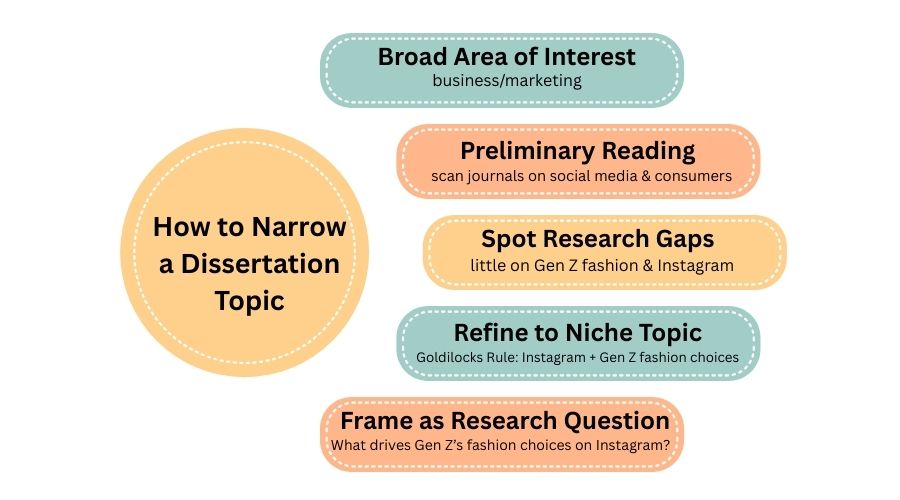
Use the “Goldilocks” principle: not too broad, not too narrow. Too much existing research means it’s hard to say something new; too little, and you’ll struggle to justify your topic. Aim for a sweet spot with room for original contribution and enough existing work to build on.
Finally, try framing your niche as a research question, like: “How do Instagram influencers affect Gen Z fashion purchases?” Keep one or two backup ideas in case your first choice runs into obstacles.
By the end of this step, you should have a clear, focused direction for your dissertation.
Step 5: Ensure Relevance and Originality
Once you’ve narrowed your focus, ask: Why does this research matter?
A strong dissertation topic isn’t just interesting to you. It should also have value in a wider academic or practical context. Many graduate programs require you to justify your topic’s significance, so think about relevance from several angles:
- Think of its academic relevance. Will your research fill a gap in the literature or address a current scholarly debate?
For PhDs, this means making an original contribution, developing a new theory, testing one in a new context, or uncovering fresh data. Master’s theses should also offer new insight, perhaps by applying theory in a novel setting or using unique data.
- Is there social or practical relevance? Does your work address a real-world problem, inform policy, or improve a process?
For example, a dissertation on improving patient handoff procedures in hospitals has clear, immediate benefits.
- Insert personal or professional relevance. Does the topic align with your career goals or long-term research plans?
If you’re heading into industry, a practically useful topic can boost employability; if academia is your path, it can help carve out a research niche.
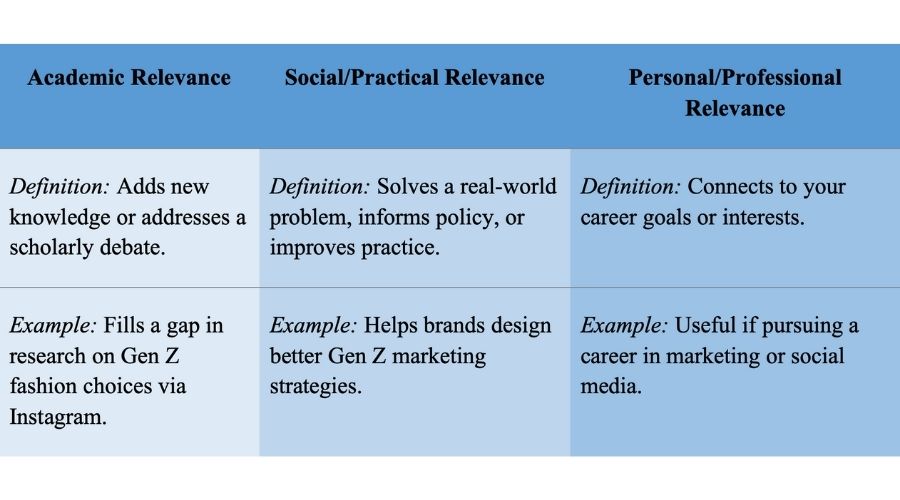
Originality doesn’t have to mean ground-breaking discoveries.
It can be studying a known issue in a new context, combining theories from different fields, or challenging current thinking. Even undergraduate projects can show originality by applying existing if knowledge to new case studies or generating local data.
For doctoral work, try the “SOCK test”—does your project make a Specific, Original Contribution to Knowledge?
Finally, draft a short paragraph explaining your topic, the gap it addresses, and why it matters. This exercise not only clarifies your thinking but also gives you a ready-made justification for your proposal or introduction.
Step 6: Consider Feasibility (Be Realistic)
An exciting idea is great. But now it’s time for a reality check.
Not every great topic works within the limits of a student dissertation. Use these checkpoints to see if yours is truly doable:
- Plan the time frame. Match your topic to the time you have. One semester for undergrad, 6–9 months for a master’s, or several years for a PhD. If your idea needs a 5-year study but you’ve got 6 months, it’s not feasible (unless existing data is available). Narrow further if needed.
- Consider the data and sources: Can you access the data you need? If you plan to collect original data, is it realistic to recruit participants or get samples? For existing data, are archives accessible and in a language you understand? There should be enough literature to support your work, without being overwhelming.
- Where will you get resources and funding? Will you need special equipment, materials, or travel? If so, do you have the funding or grants? If not, adapt. Use publicly available datasets or focus on local case studies.
- Review your skills and the methodology. Do you have, or can you quickly learn, the skills required? Advanced statistics, lab techniques, or language fluency may require extra time or training.
- Are there ethical and legal issues: Can you get ethics board approval? Sensitive topics or vulnerable participants require careful planning and compliance with regulations.
- Stay interested: After all the narrowing, are you still excited? You’ll be “living” with this topic for months or years. Make sure it still motivates you.
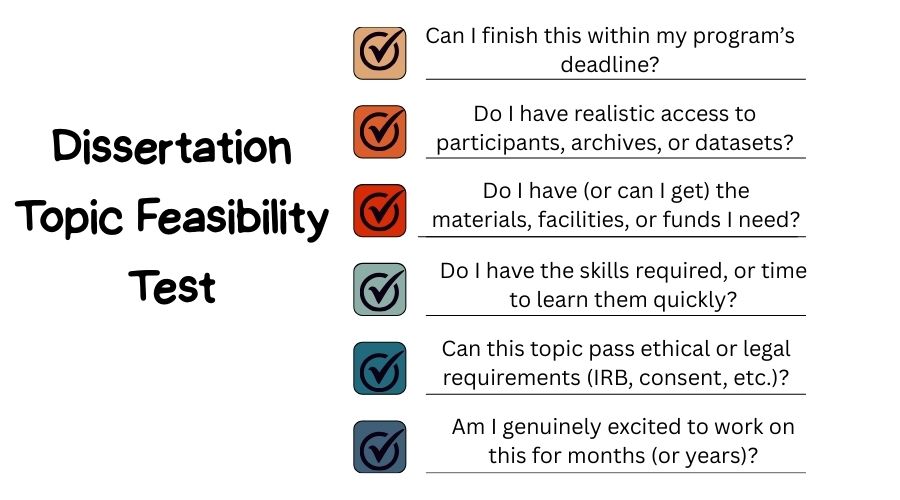
If any of these factors raise red flags, like inaccessible data or unrealistic timelines, tweak your topic now. It’s far easier to adjust early than to change course halfway through your dissertation.
Step 7: Get Feedback and Approval
By now, you should have a well-defined dissertation topic or a couple of strong contenders. The next step is to get feedback and formal approval.
Start with your advisor or supervisor. Share a short summary of your topic, why it matters, and how you plan to research it. Ask for honest feedback. They might suggest narrowing your scope, refining your question, or considering a different method. This guidance can save you from major setbacks later.
Also seek input from peers or mentors, especially those who’ve recently completed their dissertations. They can offer practical tips, point you toward useful resources, or share lessons learned.

If your department requires a short presentation or concept paper, treat it seriously. Use the feedback you get to strengthen your topic.
Finally, submit your topic for formal approval, usually through a proposal or prospectus outlining your research question, background, and methodology. Be prepared for possible revisions; they’re a normal part of the process. Allow extra time, as approval can take weeks.
If you realise early that your topic isn’t working, don’t hesitate to pivot, with your advisor’s guidance and committee approval. By the end of this step, you’ll have an approved topic and can move forward confidently into research and writing.
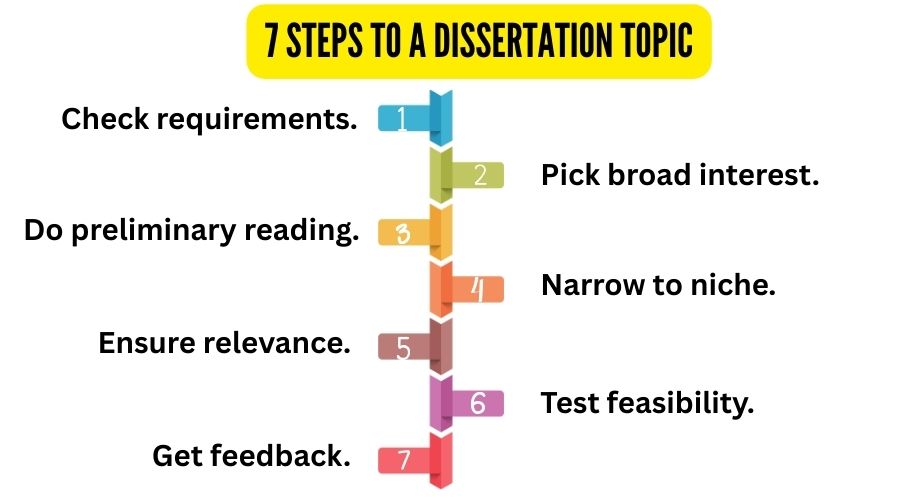
Examples of Dissertation Topic Ideas (By Level and Discipline)
Here are sample dissertation topics for undergraduate, master’s, and PhD levels in business, nursing, and psychology. They show how scope changes by level and may spark ideas, though your topic should match your own interests and context.
Undergraduate Level Examples
Undergraduate dissertations (or final-year projects) typically apply existing theories or methods to a specific case. They don’t need to make a groundbreaking scholarly contribution, but they should show strong research skills and depth of understanding.
- Business example- The Impact of Social Media Marketing on Small Business Growth in [Your City]: A Case Study.
Focused on one business or city, this uses existing marketing theory to analyse social media’s influence, with data from interviews, surveys, or sales records.
- Nursing example- Burnout and Coping Strategies among Nurses in a Community Hospital: A Survey Study.
Surveys nurses at one hospital to measure burnout and coping methods. Uses established tools, with findings relevant to local management.
- Psychology example- Social Media Use and Anxiety in College Students: A Correlational Study.
Uses questionnaires to explore links between time spent on social media and anxiety levels, applying existing scales to a specific campus population.
Each topic is narrow, feasible within a semester, and demonstrates applied research skills.
Master’s Level Examples
A master’s dissertation should show subject mastery and independent research skills, aiming for some original contribution, though in a narrower scope than a PhD. The goal is to advance understanding incrementally or combine ideas in a new way.
- Business example- Remote Work Policies and Employee Productivity: A Comparative Analysis of Two Corporations.
Compares two companies’ approaches to remote work and productivity, offering practical insights. Originality comes from collecting and analysing new data, but the scope remains manageable.
- Nursing example- Effectiveness of a Mindfulness Program in Reducing ICU Nurse Stress: A Pilot Study. Tests an 8-week mindfulness program with ICU nurses, measuring stress before and after.
Originality lies in applying a known method to a specific context and evaluating it.
- Psychology example- The Impact of Mindfulness Meditation on Test Anxiety in University Students: An Experimental Study.
Compares mindfulness training with a control group to measure exam anxiety. Narrow focus, clear outcome, and a practical experiment make it feasible within a master’s timeline.
Each topic is focused, contributes new data, and can be completed within a year.
PhD Level Examples
A PhD dissertation must make a significant, original contribution to the field.
Topics are highly specific. They deeply investigate a problem and often blend multiple studies or methodologies. They should address something that hasn’t been done in this way before, align with your advisor’s expertise, and produce new knowledge or theory worthy of publication.
- Business example- Leadership Styles and Innovation in Tech Startups: Introducing a New Model for Predicting Innovative Outcomes.
This project develops and validates a new framework linking startup leadership approaches with innovation performance. It could involve multi-country surveys, case studies, and advanced analysis, resulting in a model other researchers and companies can apply.
- Nursing example- Designing and Evaluating a Community-Based Nursing Intervention for Diabetes Management in Underserved Populations.
This involves creating an original, nurse-led program for diabetes care in low-income communities, implementing it, and evaluating outcomes like blood sugar control and hospitalization rates. The work fills a gap in healthcare research and could yield a scalable model.
- Psychology example: Longitudinal Study of Childhood Trauma’s Impact on Adult Relationships: A Mixed-Methods Approach.
Following individuals with childhood trauma histories over several years, this study combines quantitative measures and qualitative interviews to uncover how trauma shapes adult relationships, potentially refining theories and guiding interventions.
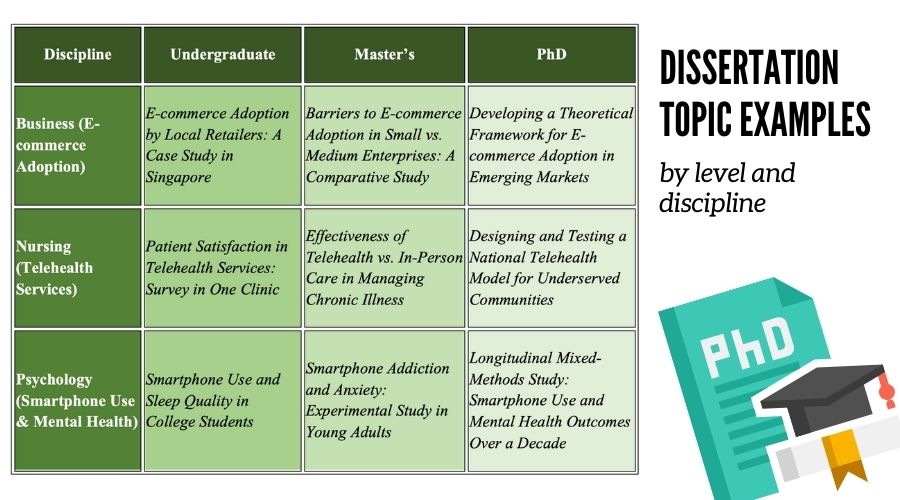
Each example shows the leap from lower-level dissertations: undergrad topics are narrow and exploratory; master’s topics add modest originality; PhD topics tackle novel, complex issues requiring years of research and multi-layered analysis.
Use these as your inspiration, as you refine your own topic into a clear research question or hypothesis that meets your program’s expectations.
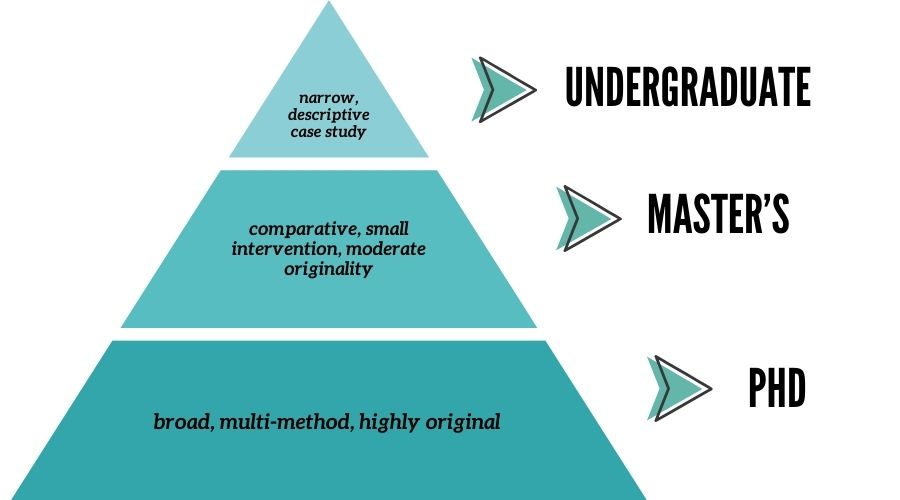
Conclusion: From Topic to Thesis
Learning how to choose a dissertation topic is one of the most important steps in your research journey.
Follow a clear process: understand the requirements; align with your interests; explore the field; narrow your niche; ensure relevance; check feasibility; and get feedback.
Don’t worry, you’ll eventually land on a topic that motivates you.

Remember, this takes time and iteration. Use your supervisor, peers, or your university’s writing support for guidance, and consider an ethical dissertation writing service for feedback or proposal help.
With the right topic, the writing phase becomes far more enjoyable, and you’re well on your way to a successful dissertation.
0 Comments
Leave a reply
You must be logged in to post a comment.


